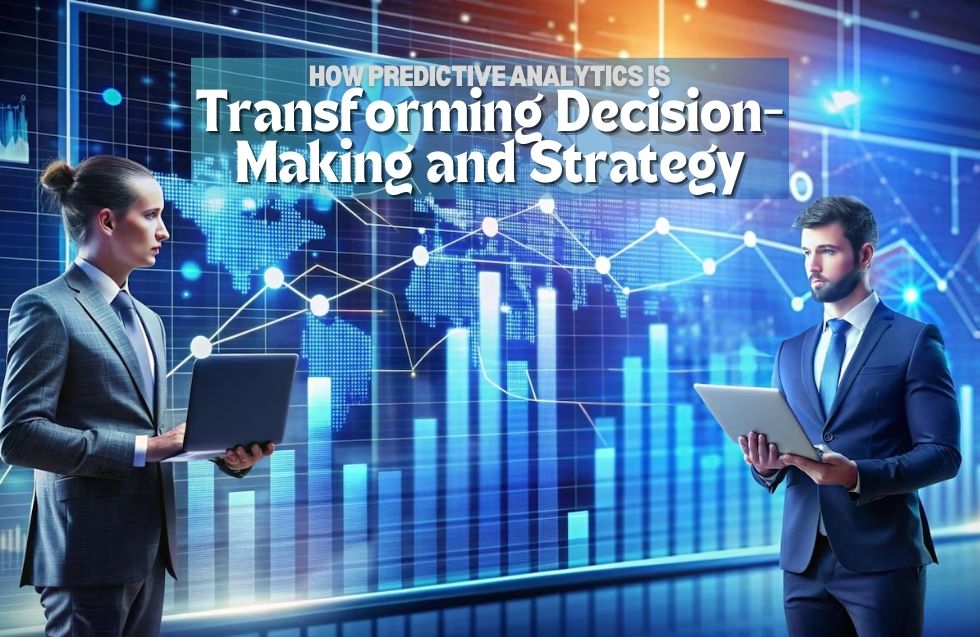In the fast-paced and highly competitive world of business, staying ahead of the curve is more critical than ever. Companies are constantly seeking new ways to gain an edge, and one of the most powerful tools in their arsenal is predictive analytics. By harnessing the power of data, predictive analytics enables businesses to forecast future trends, optimize operations, and make informed strategic decisions. This transformative technology is revolutionizing industries across the globe, allowing companies to anticipate challenges, seize opportunities, and maintain a competitive advantage.
Understanding Predictive Analytics
Predictive analytics refers to the use of statistical techniques, machine learning algorithms, and data mining to analyze historical data and make predictions about future events. It goes beyond simply describing what has happened (descriptive analytics) or why it happened (diagnostic analytics); it focuses on forecasting what is likely to happen and suggesting the best course of action (prescriptive analytics).
The global predictive analytics market is experiencing rapid growth. According to MarketsandMarkets, the market size is expected to grow from $10.5 billion in 2021 to $28.1 billion by 2026, at a Compound Annual Growth Rate (CAGR) of 21.7%. This growth is driven by increasing data generation, advancements in machine learning, and the need for businesses to gain actionable insights from their data.
The Impact of Predictive Analytics on Business Decision-Making
Predictive analytics is changing the way businesses operate, providing them with the tools to make better, data-driven decisions. Here are some key areas where predictive analytics is making a significant impact:
1. Demand Forecasting and Inventory Management
One of the most common applications of predictive analytics is in demand forecasting and inventory management. By analyzing historical sales data, seasonal trends, and external factors such as economic indicators and weather patterns, businesses can accurately predict future demand. This enables them to optimize inventory levels, reduce stockouts and overstock situations, and improve customer satisfaction.
For example, Walmart, the world’s largest retailer, uses predictive analytics to forecast demand for its millions of products. The company’s predictive models take into account various factors, including local events, weather patterns, and social media trends. This has allowed Walmart to optimize its inventory management, reducing costs and ensuring that the right products are available at the right time.
2. Customer Behavior and Personalization
Predictive analytics is also transforming customer relationship management (CRM) by enabling businesses to anticipate customer needs and personalize their interactions. By analyzing data from various sources such as purchase history, browsing behavior, and social media activity, companies can predict what products or services a customer is likely to be interested in and tailor their marketing efforts accordingly.
Amazon is a prime example of a company that excels at using predictive analytics for customer personalization. The e-commerce giant uses sophisticated algorithms to analyze customer data and make personalized product recommendations. According to McKinsey, 35% of Amazon’s revenue is generated through its recommendation engine, which suggests products based on a customer’s browsing and purchase history.
3. Risk Management and Fraud Detection
Predictive analytics is a powerful tool for risk management and fraud detection. By analyzing historical data and identifying patterns, businesses can predict potential risks and fraudulent activities before they occur. This is particularly valuable in industries such as finance and insurance, where fraud can result in significant financial losses.
For instance, PayPal uses predictive analytics to detect and prevent fraudulent transactions. The company’s machine learning models analyze millions of transactions in real-time, identifying suspicious patterns and flagging potentially fraudulent activities. As a result, PayPal has been able to reduce fraud rates significantly, providing a safer and more secure platform for its users.
4. Predictive Maintenance and Operational Efficiency
In industries such as manufacturing and logistics, predictive analytics is used to predict equipment failures and optimize maintenance schedules. By analyzing data from sensors and monitoring systems, businesses can identify patterns that indicate when a machine is likely to fail and schedule maintenance proactively. This reduces downtime, extends the lifespan of equipment, and minimizes operational disruptions.
General Electric (GE) is a leader in using predictive analytics for predictive maintenance. The company’s Predix platform collects data from industrial equipment such as turbines and jet engines and uses machine learning models to predict potential failures. This allows GE to perform maintenance before a failure occurs, improving operational efficiency and reducing costs for its customers.
5. Human Resources and Workforce Planning
Predictive analytics is also being used in human resources (HR) to improve workforce planning and employee retention. By analyzing data on employee performance, engagement, and turnover, businesses can identify factors that contribute to employee attrition and take proactive steps to address them.
IBM has developed a predictive analytics tool called Watson Talent, which helps companies predict employee turnover and identify high-potential employees. According to IBM, the tool has an accuracy rate of 95% in predicting employee turnover, enabling businesses to take targeted actions to retain their top talent.
Case Study: Netflix – Predictive Analytics in Action
Netflix, the world’s leading streaming service, is a prime example of how predictive analytics can be used to transform business strategy and decision-making. The company leverages data analytics to drive almost every aspect of its business, from content creation to customer retention.
Content Recommendation
Netflix’s recommendation engine is one of the most sophisticated in the world. By analyzing data on what users watch, when they watch it, and how they interact with the platform, Netflix can predict what content a user is likely to enjoy and suggest it to them. This level of personalization is a key driver of user engagement and retention. According to Netflix, over 80% of the content watched on the platform is based on recommendations generated by its algorithms.
Content Creation and Acquisition
Predictive analytics also plays a crucial role in Netflix’s content strategy. By analyzing data on viewer preferences and trends, Netflix can predict what types of content are likely to be successful and make data-driven decisions on which shows and movies to produce or acquire. This approach has led to the creation of hit shows like “House of Cards” and “Stranger Things,” which were developed based on insights from user data.
Customer Retention
Netflix uses predictive analytics to identify users who are at risk of canceling their subscriptions. By analyzing factors such as viewing behavior and engagement levels, the company can predict which users are likely to churn and take proactive steps to retain them, such as offering personalized content recommendations or targeted promotions.
Netflix’s data-driven approach has been a key factor in its success, helping the company grow its subscriber base to over 200 million users worldwide and maintain a leadership position in the highly competitive streaming industry.
The Future of Predictive Analytics
As technology continues to evolve, predictive analytics is expected to become even more powerful and widespread. Here are some emerging trends that are likely to shape the future of predictive analytics:
1. Artificial Intelligence and Machine Learning
Advancements in artificial intelligence (AI) and machine learning are enabling the development of more sophisticated predictive models that can analyze vast amounts of data and make more accurate predictions. According to Gartner, by 2025, AI-based predictive analytics will be a key component of 60% of all business decision-making processes.
2. Real-Time Analytics
Real-time predictive analytics, which analyzes data as it is generated, is becoming increasingly important for businesses that need to make quick decisions. This is particularly valuable in industries such as finance, where real-time analytics can be used to detect fraudulent activities as they occur, or in retail, where it can be used to personalize offers for customers in real-time.
3. Integration with IoT and Big Data
The Internet of Things (IoT) and the growing volume of big data are providing businesses with new sources of data that can be used for predictive analytics. By integrating data from IoT devices such as sensors and smart devices, businesses can gain deeper insights into their operations and make more accurate predictions.
4. Ethical Considerations and Data Privacy
As predictive analytics becomes more powerful, there are increasing concerns about data privacy and the ethical use of data. Businesses will need to navigate these challenges carefully, ensuring that they use data responsibly and transparently while maintaining the trust of their customers.
Challenges and Limitations of Predictive Analytics
While predictive analytics offers significant benefits, it is not without its challenges and limitations. Here are some of the key challenges businesses face when implementing predictive analytics:
1. Data Quality and Availability
The accuracy of predictive models depends heavily on the quality and availability of data. Incomplete, inaccurate, or outdated data can lead to incorrect predictions and poor decision-making. Businesses need to invest in data management practices to ensure that their data is clean, accurate, and up-to-date.
2. Model Complexity and Interpretability
Predictive models can be complex and difficult to interpret, especially for non-technical stakeholders. This can make it challenging to explain the results of the model and gain buy-in for data-driven decisions. Businesses need to focus on building models that are not only accurate but also interpretable and transparent.
3. Integration with Business Processes
For predictive analytics to be effective, it needs to be integrated into existing business processes and decision-making workflows. This requires a cultural shift towards data-driven decision-making and the development of tools and processes that make it easy for employees to use predictive insights in their daily work.
4. Ethical and Privacy Concerns
As predictive analytics becomes more powerful, there are increasing concerns about the ethical use of data and the potential for bias in predictive models. Businesses need to ensure that they use data responsibly, maintain customer privacy, and take steps to mitigate bias in their models.
Conclusion: The Transformative Power of Predictive Analytics
Predictive analytics is transforming the way businesses make decisions and develop strategies. By leveraging data to forecast future trends, optimize operations, and personalize customer interactions, businesses can gain a competitive advantage and achieve better outcomes. From demand forecasting and risk management to customer personalization and predictive maintenance, predictive analytics is revolutionizing industries and enabling companies to stay ahead of the curve.
As technology continues to evolve, the potential will only grow, offering new opportunities for businesses to harness the power of data and drive innovation. However, companies must also navigate the challenges of data quality, model complexity, and ethical considerations to fully realize the benefits of predictive analytics. Those that succeed will be well-positioned to thrive in an increasingly data-driven world, turning insights into action and making better decisions that propel them towards success.












